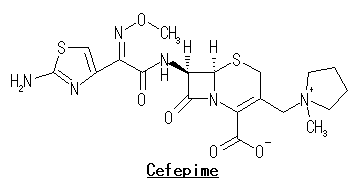Cefepime
- I. Introduction
- II. Uses of Cefepime
- III. Off-label Uses
- IV. How Cefepime Works
- V. Dosage and Administration
- VI. Composition
- VII. Side Effects
- VIII. Common Side Effects
- IX. Interactions
- X. Warnings and Contraindications
- XI. Careful Administration
- XII. Important Precautions
- XIII. Special Populations
- XIV. Overdosage
- XV. Storage
- XVI. Handling Precautions
I. Introduction
A concise account of Cefepime's background; Cefepime, also known as Maxipime is an antibiotic, from the generation of cephalosporins that was introduced during the 1990s. Its effectiveness against both Gram Gram-negative bacteria made it an essential tool in treatments.
Categorization and type of antibiotic; Cefepime falls under the category of β lactam antibiotics. Specifically, it is classified as a fourth-generation cephalosporin, which grants it a range of capabilities and increased resistance to β lactamases compared to its predecessors.
II. Uses of Cefepime
Cefepime is a cephalosporin antibiotic that is commonly prescribed by doctors to treat infections like septicemia, pneumonia, urinary tract infections, and skin infections 1. It is effective against a range of bacteria, making it a suitable option for healthcare providers. Cefepime works against both Gram-positive organisms such as Staphylococci and Streptococci as well as Gram-negative organisms like Escherichia coli, Klebsiella, and Pseudomonas aeruginosa 12. In hospitals, Cefepime is typically reserved for patients with infections or those in intensive care units 1. On the other hand, in outpatient settings, it can be used to treat uncomplicated or complicated infections depending on the specific clinical situation 1.
Here are some references that provide more information on Cefepime:
III. Off-label Uses
Off-label applications refer to the use of drugs for purposes not officially approved. Cefepime, an effective drug, has been studied for various off-label uses 1. There are clinical situations where Cefepime may be considered, such as osteomyelitis, endocarditis, and specific types of meningitis 1. When other primary treatments are not recommended or ineffective, some healthcare professionals choose Cefepime due to its safety profile 1. Although there have been case studies and smaller studies supporting the off-label use of Cefepime, in these scenarios, it is important to approach its usage and prioritize evidence-based medicine 1.
Here are some references that provide more information on Cefepime:
IV. How Cefepime Works
Cefepime works by blocking the synthesis of cell walls, which leads to the death of dividing cells. What makes Cefepime unique is its ability to resist being broken down by β lactamases, including those produced by Gram-negative bacteria. This unique characteristic expands its effectiveness against a range of resistant strains.
V. Dosage and Administration
Dosage recommendations, for infections can vary depending on the severity and type of condition. In the case of infections, it is common to take 1 2g every 12 hours while severe infections may require 2g every 8 hours.
When it comes to administering cefepime, the usual method is through administration as this ensures absorption into the bloodstream and widespread distribution throughout the body.
Regarding the duration of treatment for conditions, most infections typically require a course of 7 to 10 days. However, in cases of deeply rooted infections, extended therapy may be necessary. Could last, up to 14 days or even longer.
VI. Composition
The key ingredient found in Cefepime is Cefepime hydrochloride. Other components, such as stabilizers, buffering agents, and solvents, are also included to help maintain the drug's effectiveness and stability during storage. Depending on medical requirements, there may be variations in the formulations available for intravenous use.

VII. Side Effects
Summary of adverse reactions: Just like any medication, Cefepime has the potential to cause side effects. While most patients don't experience any or only have side effects, some adverse reactions can be serious. Distinguishing between rare side effects; Common side effects may involve mild rashes on the skin or local reactions at the injection site. However, rare side effects can include allergic reactions, diarrhea associated with Clostridium difficile, or neurological symptoms.
VIII. Common Side Effects
Commonly reported side effects and their description: Most patients may have pain or inflammation at the injection site. A few individuals might also experience issues such as feeling nauseous or having diarrhea.
Ways to manage and reduce these side effects: Most side effects will resolve independently without intervention. Applying compresses can help alleviate reactions, while symptomatic treatment can benefit gastrointestinal symptoms. It is always advisable to consult a physician if the side effects are severe or persist for some time.
IX. Interactions
Cefepime can potentially interact with various drugs, albeit in some cases. Notably, it may interact with aminoglycoside antibiotics, furosemide,, and certain diuretics.
These interactions can lead to increased risk of kidney damage. Worsen existing problems if Cefepime is used alongside these medications.
It is crucial to exercise caution when using Cefepime together with medications that can affect kidney function. Regular monitoring of kidney function and therapeutic drug levels may be necessary in situations.
X. Warnings and Contraindications
Cefepime should not be given to patients with hypersensitivity or severe allergic reactions to Cefepime or other cephalosporins. They need to avoid using it. Some risks are associated with using Cefepime, although they are infrequent but severe. These risks include developing Clostridium-associated diarrhea, experiencing Stevens-Johnson syndrome, and possible neurotoxicity, particularly at higher concentrations.
XI. Careful Administration
Keeping an eye on factors during therapy, Monitoring function tests, blood cell counts, and, in some cases, Cefepime serum concentrations when administering Cefepime is crucial.
Taking into account patients with health conditions, Patients who have insufficiency, hepatic disorders, or a history of gastrointestinal diseases, like colitis, may require closer monitoring and the possibility of adjusting the dosage.
XII. Important Precautions
Before starting Cefepime treatment, it is advisable to gather a medical history, perform allergy tests, and assess the initial condition of the kidneys and liver. It may be necessary to adjust the dosage in cases where patients have impaired kidney function. This is important to ensure that the medication is effective and to prevent any harm to the kidneys.
XIII. Special Populations
a. Administration to Elderly
As people age, their body undergoes changes that can affect how medications are processed and eliminated. In the case of Cefepime, older individuals can have levels of the drug in their bloodstream for more extended periods because their kidneys may not clear it as efficiently. Therefore, it is often advised to make dosage adjustments based on function when prescribing this medication to elderly patients.
b. Administration to Pregnant Women and Nursing Mothers
Based on the safety data, it appears that Cefepime carries risks during pregnancy. However, it's important to note that there is a lack of studies in this regard.
When considering Cefepime during pregnancy, it is recommended to exercise caution and weigh the risks against the benefits. It may be used judiciously if necessary.
For lactating mothers, it's advised to be cautious as Cefepime can be excreted in breast milk.
c. Administration to Children
Dosage recommendations based on age: When it comes to children, the dosing guidelines usually consider their weight. There are specific dosage regimens for newborns, infants, and older kids. Safety considerations for children: Cefepime has a safety profile in patients that is similar to adults. However, monitoring neonates and infants is essential to ensure their well-being.

XIV. Overdosage
Signs of taking much Cefepime: If someone takes an excessive amount, they may experience cerebral irritability that could lead to seizures. It's also possible to notice signs of kidney problems. What should be done if there is an overdose? It's crucial to seek medical help. While hemodialysis can help remove Cefepime from the body, the primary focus should be providing supportive care.
XV. Storage
To ensure the storage of Cefepime, keeping the vials at room temperature, away from excessive moisture and direct sunlight is recommended. Regarding stability and expiration, it is essential to note that while the dry powder has a long shelf life, reconstituted solutions should be used promptly or refrigerated for a limited period.
XVI. Handling Precautions
When handling and getting rid of Cefepime, following some safety measures is vital. Wear gloves and avoid any contact with the drug on your skin or eyes.
For health professionals involved in preparing and administering the medication, minimizing the risk of contamination is crucial. This can be achieved by using techniques during both reconstitution and administration processes. Don't forget, once you're done, dispose of any used vials and administration sets per biohazard disposal guidelines.

























